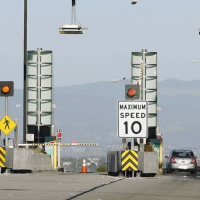Treasurer’s Office Report Says Default Is Likely if Road Tolls Aren’t Extended 13 Years
 Endangered toll plaza on the San Joaquin Hills toll road (photo: Don Leach, Daily Pilot)
Endangered toll plaza on the San Joaquin Hills toll road (photo: Don Leach, Daily Pilot)
The agency that controls Orange County’s 51 miles of failed toll roads in Southern California wants to restructure its $2.4 billion debt and delay by 13 years, until 2053, the date when the freeways become free for drivers.
Last week, a report (pdf) out of state Treasurer Bill Lockyer’s office recommended the Foothill/Eastern Corridor Transportation Agency get the green light, otherwise, it will probably default on its existing bonds. The agency approved undertaking the restructuring last month.
The toll roads were built a few decades ago and competed with the free 405 and 5 Freeways for ridership. It didn’t go well. Toll rates have been raised a dozen times since 1997 and ridership has been far short of projections, leaving revenues in shambles. Toll operators blame the bad economy, improvements to the public highways and opposition to expansion plans for much of their woes.
Despite their financial problems, or perhaps because of them, an effort was made to extend the Foothill-Eastern corridor through the heart of the San Onofre State Beach, threatening endangered species, reducing available recreation space and impacting training exercises at the U.S. Marine Corps base at Camp Pendleton. The California Coastal Commission rejected the plan and the U.S. Department of Commerce concurred.
They continue to seek piecemeal extensions of their routes, which critics claim are maneuvers to avoid environmental restrictions.
The report, by Montague DeRose and Associates, listed three reasons why the state should care about the debt restructure. First, the public/private venture will pay between $14.1 million and $18.9 million to the California Department of Transportation (Caltrans) between 2041 and 2053. Second, a default would look bad to investors and make it tougher for the state to raise money in capital markets. And, third, it is in the public interest that the tolling end and the roads become part of the state freeway system. The report mentioned, but did not note, the irony that restructuring will delay that day by 13 years and break a promise to voters who originally voted for the toll road plan.
The toll roads were built using an innovative public-private model that offered hope to those seeking new ways to finance roads in California. Toll roads have been used in other states for years, especially on the East Coast. Their proponents tout them as more efficient and a way for cash-strapped governments to tap marketplace capital for infrastructure projects.
–Ken Broder
To Learn More:
California Toll-Road Bonds at Risk Without Fix, Lockyer Says (by Michael B. Marois, Businessweek)
O.C. Tollway Could Default without Refinance Plan, Study Finds (by Dan Weikel, Los Angeles Times)
Ill-Conceived Southern California Toll Roads Struggle to Survive (by Ken Broder, AllGov California)
Report to State Treasurer on Orange County Toll Roads (Montague DeRose and Associates) (pdf)
- Top Stories
- Controversies
- Where is the Money Going?
- California and the Nation
- Appointments and Resignations
- Unusual News
- Latest News
- California Forbids U.S. Immigration Agents from Pretending to be Police
- California Lawmakers Urged to Strip “Self-Dealing” Tax Board of Its Duties
- Big Oil’s Grip on California
- Santa Cruz Police See Homeland Security Betrayal in Use of Gang Roundup as Cover for Immigration Raid
- Oil Companies Face Deadline to Stop Polluting California Groundwater





